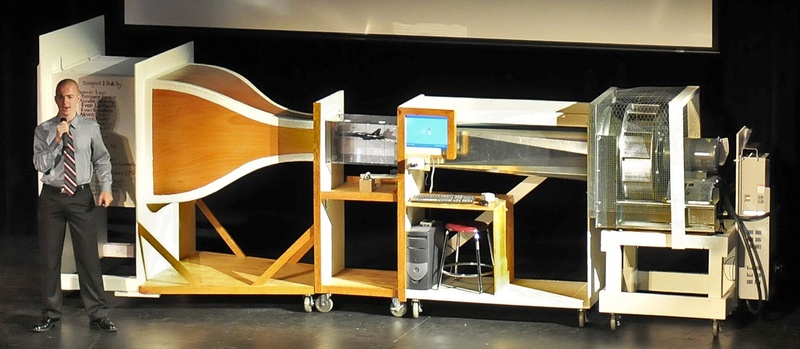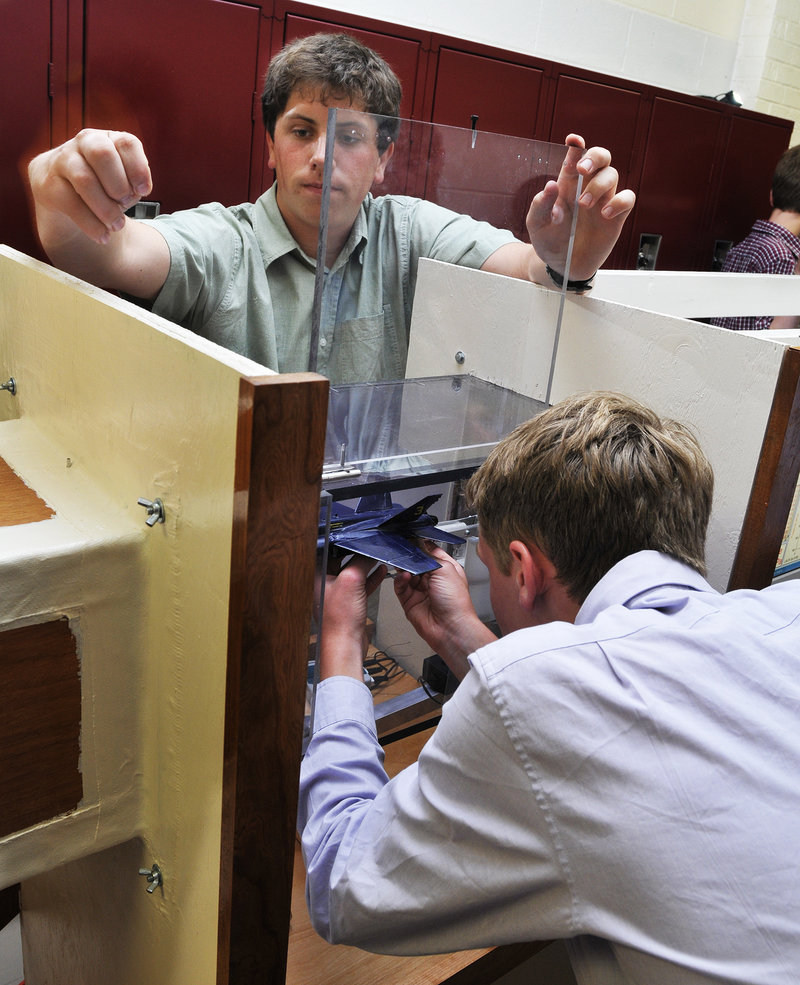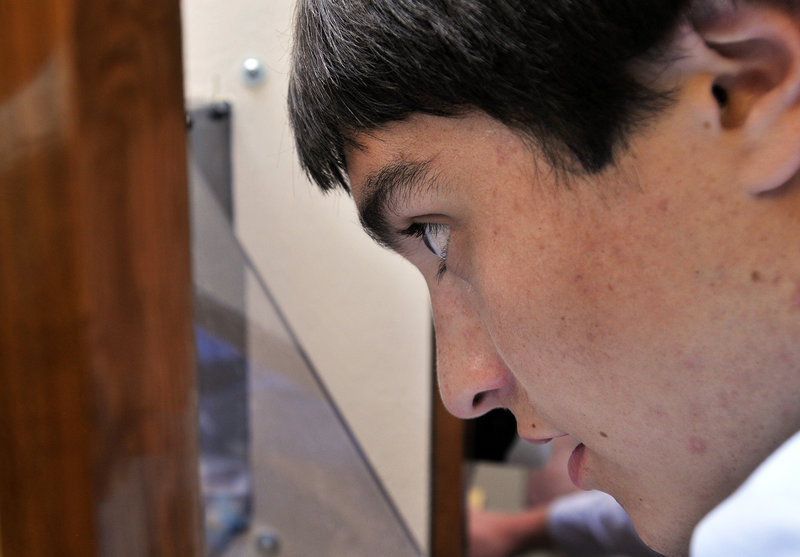FREEPORT – There are plenty of reasons why Olivia Fowler’s favorite course at Freeport High School is engineering and technology.
Olivia, a sophomore, is training for her pilot’s license and one day hopes to work for NASA. But the joy she gets from the elective engineering course taught by Jon Amory is more immediate.
“In most classes, teachers just lecture to us,” Olivia said. “Mr. Amory said, ‘Build a wind tunnel,’ and we figured out how to do it.”
On Thursday, Olivia and her eight classmates presented and demonstrated the wind tunnel they built this year to an audience of students, teachers, parents, engineers and others.
The tunnel produces wind in a clear, foot-square testing chamber, where digital sensors gauge the drag and lift on items ranging from a tennis ball to a scale model of a Blue Angels Navy jet.
“It’s really the best way to test the aerodynamics of objects,” said Evan LaMarre, a senior, at the start of the presentation.
The Falcon Wind Tunnel, named for the school’s mascot, is believed to be the most powerful wind tunnel ever designed and constructed by high school students, Amory said.
Built to generate wind speeds as high as 150 mph, the Falcon actually reaches 175 mph. That’s double the wind speed produced by a larger wind tunnel at the University of Maine, Amory said, and 3½ times as powerful as the NASA-sponsored wind tunnel built at Gen. B.O. Davis Jr. Aviation High School in Cleveland.
“If a group of college seniors built this, I would be impressed,” Amory said after the students’ presentation. “There are 20 different ways to build a wind tunnel. They had to figure out the best way to build this one. They had to work so hard, and they had to do it themselves.”
Amory, a second-year teacher and Portland native, was a robotics engineer at Boston Dynamics in Waltham, Mass., before returning to Maine. He helped to plan and organize the wind tunnel project, he said, but he left design decisions and construction to his students.
The project was funded by a $5,500 grant from L.L. Bean, with additional help from SolidWorks, Horizon Solutions, Rockwell Automation, Keith Trembley Builders, Greenheck Fan Corp., HoneyCommCore and other companies.
Comparable wind tunnels cost as much as $60,000, Amory said.
Amory’s students kept costs down by seeking parts and materials donated or provided at cost by local and national firms. They also employed a boat-building technique known as “stitch and glue,” which allowed them to bind the edges of thin plywood sheets to fabricate the tunnel’s wind contraction cone.
“To be able to make the cone out of wood instead of sheet metal really was key to doing this project for the money we had,” Amory said.
The 20-foot-long wind tunnel was made in sections so it could be dismantled, moved and stored more easily, Evan LaMarre told the audience. It includes a settling chamber, where air is drawn into the machine; a testing chamber, where a computer monitors adjustments in wind speed on test subjects; and a 27-inch-diameter centrifugal fan, which pulls air into the wind tunnel.
The project gave Amory’s students hands-on experience in solving an open-ended engineering problem, requiring them to sift through multiple design possibilities, choose the best building materials and fit them together properly.
They also learned to work as a team, developing work plans, delegating tasks, staying on time and on budget and delivering a professional final presentation, complete with computer slides and diagrams, to explain what they did and what they learned.
“This was a unique experience,” said senior Ben Forster. “Something I learned right off the bat is how important communication is.”
Spencer Egan, Max Jennings, Evan Goodwin, Alison Rice, Clifford Anderson and Kersti Bayne also worked on the wind tunnel and participated in the presentation.
Amory hopes to integrate the wind tunnel into the curriculum so students in various courses can study the principles of aerodynamics, engineering and related topics. It will be a rare opportunity for a high school.
The audience at Thursday’s demonstration included Steve Serfling, executive vice president of engineering and product development at Kestrel Aircraft in Brunswick. Serfling has recruited students to work at his company, at both the high school and college levels.
“This is the first time I’ve seen a project and a presentation of this scale in a high school,” Serfling said.
No one was more proud than Olivia Fowler’s dad, David, who watched the wind tunnel demonstration in awe.
“It’s very impressive,” he said. “I saw pieces of the wind tunnel as it was being put together, but I was still quite floored today. I had no idea how in-depth and large this project was.”
Staff Writer Kelley Bouchard can be contacted at 791-6328 or at:
kbouchard@pressherald.com
Send questions/comments to the editors.





Success. Please wait for the page to reload. If the page does not reload within 5 seconds, please refresh the page.
Enter your email and password to access comments.
Hi, to comment on stories you must . This profile is in addition to your subscription and website login.
Already have a commenting profile? .
Invalid username/password.
Please check your email to confirm and complete your registration.
Only subscribers are eligible to post comments. Please subscribe or login first for digital access. Here’s why.
Use the form below to reset your password. When you've submitted your account email, we will send an email with a reset code.